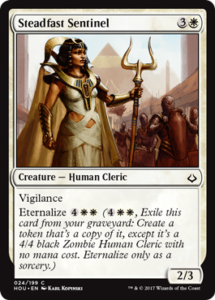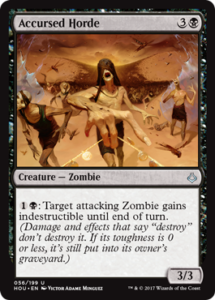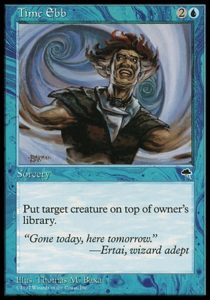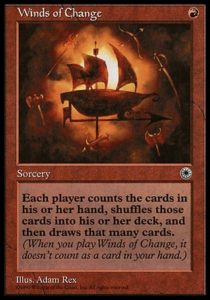Another massive Grand Prix Las Vegas is in the books, and it brought with it a pretty hefty amount of spoilers. There’s a whole lot to digest between the Invocations, the new Afflict mechanics (which is a modular and keyworded version of [casthaven]Vedalken Ghoul[/casthaven]’s ability), the evolution of Exert to tap abilities, the awesome design of [casthaven]The Scorpion God[/casthaven], and the Gatewatch losing their first big fight. But I’m not going to focus on any of that. Today I want to discuss Eternalize and its relationship to its ancestor Megamorph.

Bigger, Badder Embalm
Eternalize is a slightly more complicated version of Embalm. It’s worth noting that Embalm is already a rather complicated ability. Its reminder text is five lines long, while Eternalize’s is six—the same length as Suspend‘s reminder text. Eternalize also lets you exile a creature from the graveyard for a token copy, except the token is black (instead of white) and is always a 4/4 (instead of having the original’s stats). One might say, “well, that’s unoriginal—it’s the same mechanic, but bigger.” That’s a fair point, but I think Eternalize is brilliant design.
Eternalize succeeds at what Megamorph tried to do: tell a flavorful story purely through comparative mechanics. Eternalize says, bluntly: “Remember Embalm? This is like that, except you really want your creature to die so it can come back stronger.” It encourages you to be even crueler with your creatures. If you look at the token’s art, you see an intimidating, metal-clad zombie, which drastically contrasts with the placid, wrapping-bound mummies of Amonkhet.
From the other cards in the pack, you’re likely to recognize that Bolas has returned to wreck the world; and if you do, you may recognize that Bolas is harvesting these people into an undead army. These aren’t the peaceful, white, community-serving zombies you once knew, these are murderous, weapon-wielding, black Terminator zombies. Eternalize is recognizable enough that it is a clear continuation of what we already know about the world, but is distinct enough that it communicates a clear change to the story (the zombies are bigger, meaner, and better off undead).
Megamorph tried to tell a story like this, but it had a far less flavorful mechanic (Morph is ancient dragon Magic that you hide under) and a less flavorful execution (Megamorph is also dragon Magic that you hide under, but it makes you a little bit bigger after you use it?). Both mechanics are “the same, but bigger,” but Eternalize has enough flavor that the change actually makes sense.

Eternally Different Gameplay
Having similar mechanics with different gameplay helps differentiate them and make them more enjoyable. Megamorph has almost the same gameplay as Morph: both let you play your creatures as [casthaven]Gray Ogre[/casthaven]s. Megamorph takes away a bit of your choice in the matter, as it encourages you to play creatures face-down so you can get the counter (but many Morph creatures had abilities from being turned face up, so it’s not radically different). It tended to go on smaller creatures or have higher un-Morph costs to compensate for the counter, but overall, it made for similar game states.
I predict that Eternalize and Embalm will have very different gameplay. Consider [casthaven]Unwavering Initiate[/casthaven] and [casthaven]Steadfast Sentinel[/casthaven]. [casthaven]Unwavering Initiate[/casthaven] is a solid creature—it has reasonable stats for its cost, has vigilance (which is powerful in a format where taking a turn off to block can be game-losing), and its three power means it can trade with most ground creatures. To top it all off, Embalm means you can do all of that again.
[casthaven]Steadfast Sentinel[/casthaven] is, on its face, a much worse card. A 3W 2/3 vigilance is a very weak creature and six mana is a much heftier cost to pay than five (particularly in a format as aggressive as Amonkhet). While you’re happy to race with or trade your [casthaven]Unwavering Initiate[/casthaven], you really want to trade your [casthaven]Steadfast Sentinel[/casthaven]. Embalm allows you to play a longer game, whereas Eternalize encourages you to do so.

A Slower Format?
When it was first spoiled, I expected Amonkhet to be a slow, grindy format. After all, it has three mechanics which reward slower decks: Cycling, Embalm, and Aftermath. I was wrong. Sure, you can draft very powerful slower decks, but the aggressive decks are so much more powerful. It turns out that Amonkhet is defined by Exert—by making profitable blocking difficult, it makes games tend to be decided by who can turn their creatures sideways faster and mitigates the efficacy of slow cards.
I’d bet on one of two things: either Hour of Devastation Limited is going to be much slower than Amonkhet (which will allow slower mechanics like Eternalize to be played), or aggro will continue to reign supreme and Eternalize will be worse than Embalm. I think that the former is considerably more likely, given that Exert is moving onto creatures with tap abilities (which will discourage attacking with them) and presumably will be on fewer attack triggers. This change in game pace could also match the narrative beautifully (what we in the business call ludonarrative consonance): while in Amonkhet, the world was defined by living warriors pushing themselves to the limit to pass the trials of the gods, in Hour of Devastation, people are just trying to survive against an ever-growing army of killer zombies.

An Eternalized Future?
I believe that Eternalize (and other mechanics like it) could be a solution to the problem of limited design space. Not all mechanics can be brought back repeatedly or be continually evolved. However, players have a continuous need for novelty, meaning sets need to have new mechanics. This has led to very constrained and less successful mechanics, such as Cohort (which was a tweak on Formidable, which also wasn’t the best mechanic and was based on the unnamed Naya 5-power-matters mechanic). We’ve seen poorly received mechanics be rehabilitated in the past, perhaps most famously with Chroma becoming Devotion (a technically weaker mechanic with amazing flavor), but we’ve not yet seen successful mechanics evolve gracefully into new mechanics. Eternalize might be the perfect exemplar for how that can be done.
Embalm is a neat mechanic which could have a lot of design space, but is hamstrung by its flavor and high complexity (it has a lot of text, has weird rules interactions, and demands a record-setting number of tokens). Eternalize gets to piggyback on those restrictions (because people playing the format by and large already know what Embalm does) and be a distinct mechanic which tells its own story and has its own gameplay.
At least, that’s what I hope as I peruse these new cards. Of course, there’s no substitute for actually playing with them. Here’s looking forward to seeing the rest of the set over the next couple weeks and the imminent prerelease.
And, as always, thanks for reading.
Note: this article concluded with the Portal version of Winds of Change, because some of us like that artwork. Apologies to Blake Rasmussen.
—Zachary Barash
Zachary Barash is a New York City-based game designer. He misspelled Embalm as Emblam at least twenty times while writing this article. He has an MFA in Game Design from NYU, is a game designer for Kingdom Death: Monster, and does freelance game design.
His favorite card of the month is [casthaven]Supernatural Stamina[/casthaven]. It’s a one-mana combat trick that doesn’t actually save a creature from dying… except it does, blinks it, and kind of exerts it. It manages to tell a whole lot of story and be a powerful, flexible combat trick for only one mana.

